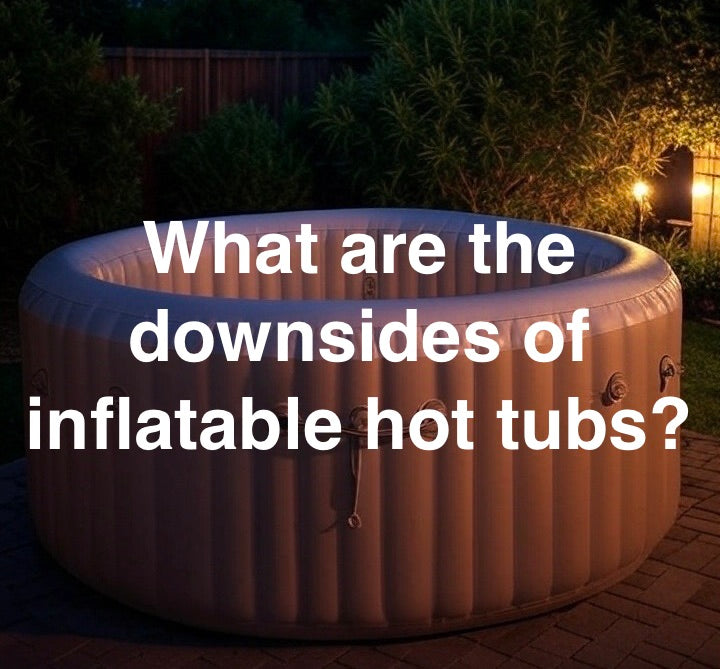
What Are the Downsides of Inflatable Hot Tubs?
Inflatable spas promise bubbly bliss on a budget—but are they really the family-friendly haven they seem? Short answer: yes, but with strings attached. From flimsy walls to soaring energy bills, we’ll reveal the perks and pitfalls so you know whether to dive in—or dodge the splash!

The Hidden Costs and Performance Problems of Inflatable Hot Tubs
High Running Costs and Poor Energy Efficiency
Slow and Inefficient Heating
If you’ve ever tried to run a bath in winter, you’ll know the frustration of lukewarm water. Inflatable hot tubs are similar.
They often take hours to heat up, which isn’t ideal when the kids are already in their swimsuits and asking, “Is it ready yet?” Unlike hard-shell tubs, the heater isn’t built for speed, so you can expect longer waits before the bubbles feel inviting.
That delay can quickly take the shine off spontaneous soaks.
Rapid Heat Loss and Poor Insulation
Even once it’s hot, keeping it that way is another challenge. Inflatable spas lose heat fast thanks to their thinner walls and basic insulation.
A decent cover helps, but if you’re soaking outdoors on a chilly evening, you’ll notice the water temperature dip. And of course, the heater then works harder—sending your electricity bills north.
Unsuitable for Cold Climates
Dreaming of a cosy December dip under the stars? Sadly, inflatables don’t cope well with British winters.
Because they lose heat quickly, many families end up with tepid water instead of toasty warmth. It’s frustrating if you’ve pictured festive bubbles and instead find yourself shivering after ten minutes.
Durability and Lifespan Issues
Susceptibility to Punctures and Damage
Here’s the biggie: inflatable tubs are exactly that—inflatable. Which means they’re not immune to punctures.
A stray twig, an excited pet, or even rough play from the kids can lead to leaks. One small puncture may not sound like a big deal, but it can take your tub out of action until repaired.
Not quite the stress-free spa you had in mind.
Short Lifespan Compared to Traditional Hot Tubs
A well-kept hard-shell tub can last a decade or more. Inflatables, however, tend to manage between two and five years.
That’s fine if you’re testing the waters before committing to a permanent model. But if you want something that grows with your family, you may be disappointed by how short-lived they are.
Difficulty and Expense of Repairs
Even small repairs aren’t always straightforward. Yes, patch kits exist, but not all leaks are easy to find or fix.
Replacement parts can also be tricky to track down. Before long, families can end up spending almost as much on repairs as they did on the tub itself.
Limited or No Warranty
Another catch? Many inflatables come with limited cover—or none at all.
So, if a fault appears after a year, you could be left footing the bill. Compare that with hard-shell tubs, which usually carry stronger warranties for peace of mind.
Inferior User Experience

Lack of Powerful, Targeted Jets (Bubble vs. Massage)
The “massage” you get from most inflatable spas isn’t really a massage at all. Instead of strong hydro jets, you’re usually just sitting in a tub of bubbles.
Fun for kids, yes. But if you’re after a proper muscle-soothing soak after football practice or a long workday, you’ll likely be underwhelmed.
Uncomfortable and Cramped Seating
Seating is another issue. Most inflatables don’t have proper moulded seats—just soft sides to perch on.
That means less comfort for long soaks. And while a “four-person” tub sounds roomy, in reality it often feels cramped with just two adults and a couple of kids.
Deceptive Sizing and Wall Thickness
Manufacturers aren’t always realistic with their sizing labels. A six-person tub? Only if everyone sits like sardines.
Add in the fact that the inflatable walls take up space inside, and the usable room is even smaller. It’s a classic case of “expectation vs reality.”
Higher Noise Levels from the Blower
Finally, there’s the noise factor. The blowers that power the bubbles can be surprisingly loud.
That’s not just distracting—it can spoil the relaxing atmosphere. And if your neighbours are close by, you might not be the only ones hearing it.
Maintenance and Safety Concerns
Poor Filtration Systems
Inflatable tubs often come with basic filtration. Fine for a quick soak, but less effective at keeping water clean long-term.
Cloudy or murky water can appear faster than you’d like, leaving you scrubbing and rebalancing more often than expected.
More Frequent Water Changes and Chemical Rebalancing
Because of weaker filters, you’ll need to drain and refill more regularly. Add in the extra chemicals needed to keep things safe, and it quickly becomes more hands-on than many parents imagined.
It’s not just an easy “set and forget” spa experience.
Potential Safety Risks for Children
For families with little ones, safety is a big consideration. Soft, bouncy walls can tempt kids to lean, climb, or even topple in unexpectedly.
While fun in theory, it creates risks if children aren’t closely supervised. A permanent tub with stronger structure often feels more secure.
The Trade-Offs: When Convenience Comes at a Price
Inflatable vs. Hard-Shell Hot Tubs: A Comparison
Initial Cost vs. Long-Term Value
Inflatable hot tubs win on upfront price—no question. They’re often a fraction of the cost of hard-shell models.
But factor in higher running costs, shorter lifespan, and repairs, and the long-term value isn’t always as good as it looks on paper.
Portability vs. Longevity
One of their biggest perks is portability. You can deflate, move, and store them easily—ideal for renters or small gardens.
But that flexibility comes at the cost of sturdiness. If you want something that lasts, a permanent spa is the safer bet.
Ease of Setup vs. Performance and Features
There’s no denying the appeal of quick setup—you can be bubbling away the same afternoon.
But the compromise is clear: weaker jets, slower heating, and fewer features than a hard-shell spa. It’s a case of convenience now, performance later.
Final Thoughts: Is an Inflatable Spa Right for Your Family?

Inflatable hot tubs definitely have their place. They’re fun, affordable, and brilliant for a few summers of bubbly family memories.
But they’re not built to last forever. If you’re hoping for deep massages, year-round warmth, or a spa that grows with your kids, a hard-shell tub is worth the extra investment.
As parents, we know family downtime is precious. The right hot tub should make life easier, not add extra stress. So weigh up whether you want short-term fun or long-term relaxation before taking the plunge.
Have you checked out our other posts?
What Are The Negatives Of Inflatable Hot Tubs?
Do You Sit On The Floor With An Inflatable Hot Tub?
How Long Do Inflatable Hot Tubs Usually Last?
What Is The Life Expectancy Of An Inflatable Hot Tub?
Do Inflatable Hot Tubs Puncture Easily?
How Often Should I Change My Inflatable Hot Tub Filter?
What Is The Best Thing To Clean The Inside Of An Inflatable Hot Tub?
Are Inflatable Hot Tubs A Lot Of Maintenance?
Should You Leave An Inflatable Hot Tub On All The Time?
Are Inflatable Hot Tubs Durable?



Leave a comment